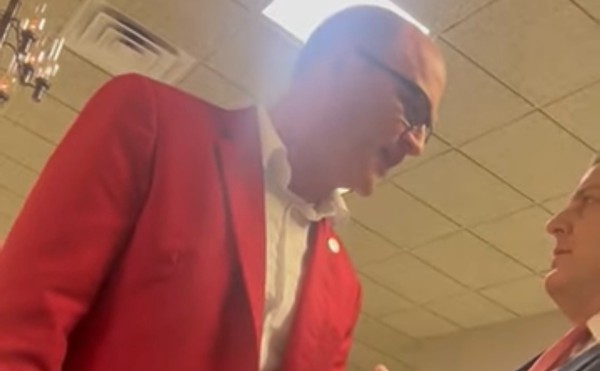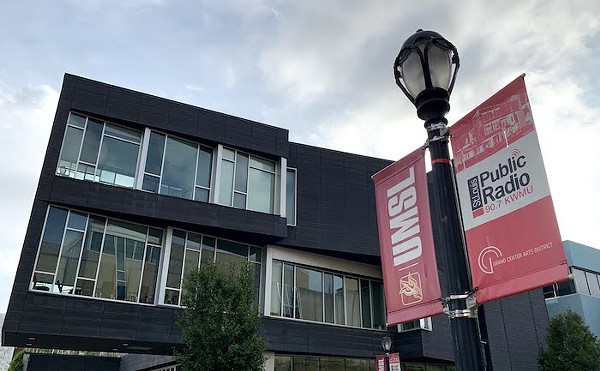On the same day the state released those sorry scores, the St. Louis Board of Education's meeting turned to chaos. Infighting among board members in a closed session resulted in security guards' being called to restore order.
The ship of schools is not just adrift, it's sinking.
And what exactly is the Missouri Legislature doing?
Sending out a little lifeboat called "charter schools" that may -- or may not -- save a tiny percentage of students. That's about it. No declaration of emergency, no radical reforms, no more money.
"Charter schools were originally proposed by people who really were hostile to public education, and there was a segment out there promoting it as an alternative to public education, and what they really wanted was vouchers and taxpayer funding for private schools," says state Sen. Ted House, a Democrat from St. Charles who was chairman of the education committee until this year, when his party lost the majority. House considers himself a champion of public education and authored the 1998 bill that allowed charter schools in St. Louis and Kansas City.
Among those "hostile" to public education may very well be House's colleague Sen. Peter Kinder, a Republican from Cape Girardeau, president pro tem of the Senate and one of the state's leading proponents of charter schools. Kinder is generally considered to be from the Taliban faction of his party, and the targets of his unholy war have included unions and public-school teachers.
For instance, he proudly notes that among the host of state rules and regulations that charter schools are exempt from is one allowing them to have up to 20 percent of their teaching staff without state certification. "'Certified' means that you took 900 hours of advanced techniques in blackboard-erasing in graduate school in a college of education," he says. "Einstein could not teach physics, Bill Gates could not teach a computer course, Steve Forbes could not go in and teach economics because they never submitted themselves to the indignity of education courses. So the master engineer who retires at age 53 from Boeing after 30 years could go and teach physics at charter schools, never having set foot inside a college of education."
Well, if it's such a good idea -- and it may be a debatable point -- to not require certification, then why not allow all public school districts to relax or abandon certification? In fact, why not allow all public schools to be free from the same set of regulations -- which cover curriculum, class size, libraries, guidance and counseling, and the requirement that schools have 174 days and 1,044 hours of academic instruction -- that charter schools are exempt from?
"Because you couldn't pass it," says Kinder. "There aren't enough votes."
This is a recurring refrain. Both Kinder and House had similar answers to another question -- which has never been asked, let alone answered -- regarding the charter-school law both of them supported: Given that the law simply allows charter schools and doesn't impose or require them, why did the bill restrict such schools to Kansas City and St. Louis?
"You're making a rational, logical, persuasive argument, and the answer is political pragmatism," says House. "I mean, it never would have passed if it had been statewide -- and the reason is that in small towns, very often, the school superintendents are very big fish, and they run the town, a lot of times. And those superintendents wanted no part of this. They were afraid of their kingdom being interfered with, and so rural legislators responded to that. It simply wouldn't have passed at all."
Says Kinder: "The bill almost certainly would not have passed" if the schools were allowed statewide.
Never mind that 35 districts statewide have "provisional accreditation," the same as the St. Louis district (the Kansas City district is the only unaccredited one in the state).
Both legislators acknowledge that charter schools are an experiment, that the jury is still out on whether they can provide a better education than existing public schools and that something "radical" had to be done to meet the hunger of parents for an alternative. Kinder refers to the charter-school law as "a linchpin for reform." House talks about it as a "safety valve" needed to let parents "blow off steam," before they became desperate enough to demand vouchers "which would destroy public education."
But neither man can point to what exactly makes a public school -- charter or otherwise -- do a good job of educating kids. The supposed advantages of charter schools are that they are exempt from state regulations, they have no central bureaucracy, they are more accountable to their constituents and they will somehow provide what House calls "an administrative or strategic model" for the regular public schools.
Meanwhile, the same legislators have elected to ignore some basic measures that obviously would help improve city schools, such as decreased class sizes. "I'm open to that," Kinder says, but he hasn't lifted a finger to push for it.
How well are charter schools doing, and will the public schools actually improve as the result of the "competitive" model? Unfortunately, the answers so far are not heartening.
Since the 1998 law was enacted, 17 charter schools have opened in Kansas City, with a total enrollment of about 5,600; St. Louis has five schools with about 1,400 students.
As for the academic performance of charter schools, there hasn't been much good news to report. Jocelyn Strand, director of charter schools for the state Department of Elementary and Secondary Education, says the only test scores in so far are from the 1999-2000 school year from Kansas City's charter schools (St. Louis had no charter schools that year). The results are "same or lower than" the regular public schools. "There were a few that scored higher, but mostly they did not score as well as the district schools," she says.
Financially speaking, the two districts are taking a hit from charter schools. Surprising to most observers is the fact that an estimated 30 to 40 percent of charter-school students are coming from private or parochial schools. Although the state and federal governments provide their share of the revenue -- at about $6,000 per student in St. Louis -- the local tax revenue must come from the school district. In Kansas City, the 17 charter schools were paid $39 million last year, and in St. Louis, the four schools were paid $9.4 million, according to figures provided by the two districts. About 45 percent of that money -- roughly $22 million -- came from local taxes that otherwise would have remained in the districts.
There is a more intangible negative effect of charter schools. "One of the potential weaknesses of charter schools is that you tend to pull some of the motivated students and parents out of the regular public schools and into the charter schools," says House. "That could be a problem. I do worry about that."
Kinder, who refers to charter schools as a "beacon of hope in the dark night" for parents, envisions entire charter-school districts. House simply hopes that they can provide a clue to improving the existing districts. But House insists that even if the charter-school lifeboat can accommodate only a small percentage of students, it's worth it. "If, by doing this, we have created a better opportunity for students than they otherwise would have had, without doing it to the detriment of anybody else, then we have succeeded," House says. "If one child gets a better education and lives a better life, than that's what this is all about."
The irony of that statement is a bit much. For the past two decades, proponents of the voluntary-desegregation program in St. Louis argued the same thing -- it might not entirely solve the problem of inequality of educational opportunity for all city students, but it was at least providing a better education for the black students who hopped on buses to go to St. Louis County schools each year.
The 1998 charter-school provision was part of a larger bill designed to phase out the desegregation program, which allowed roughly 13,000 city students to attend schools in county districts. That punched a hole in a much larger lifeboat than charter schools will ever provide.





